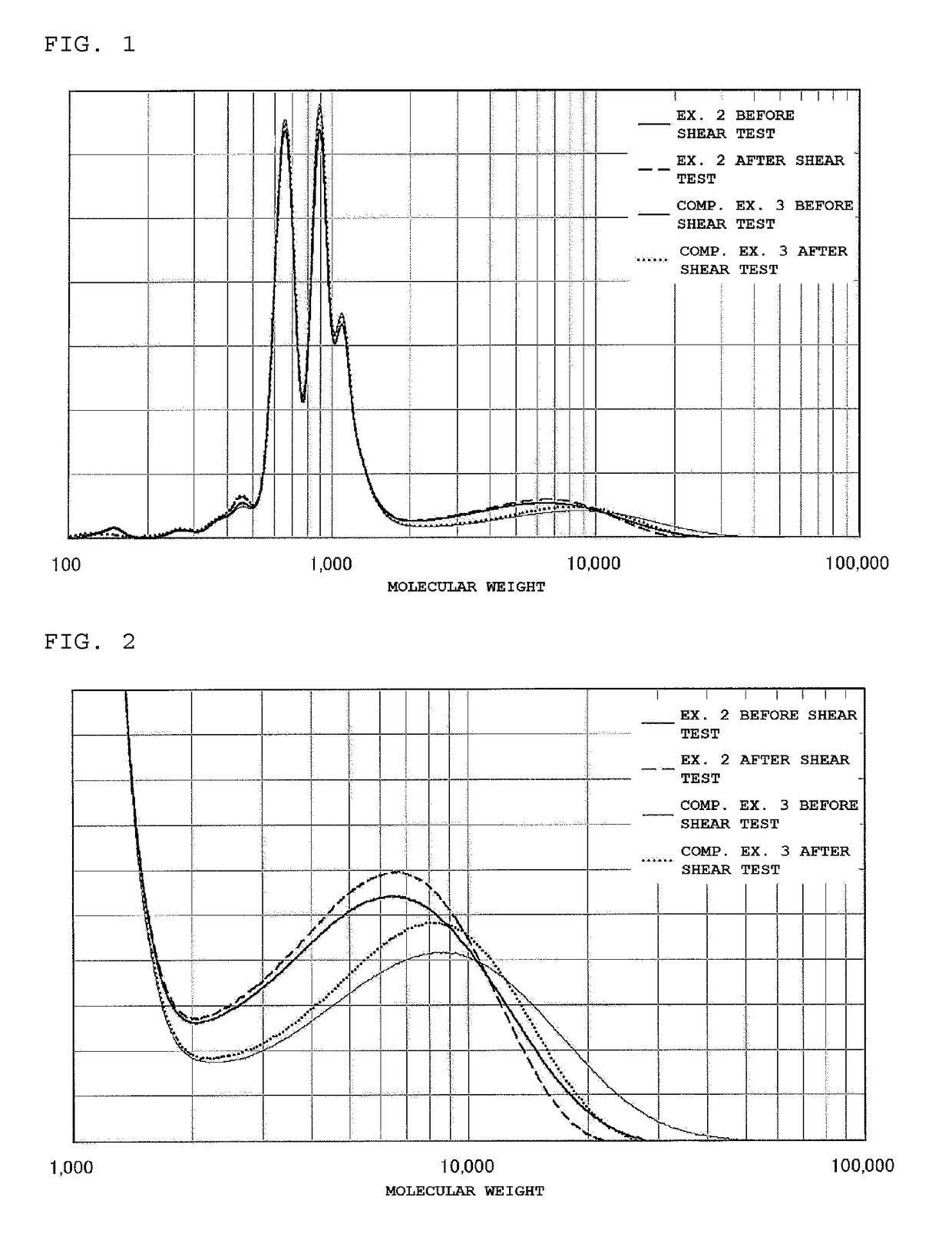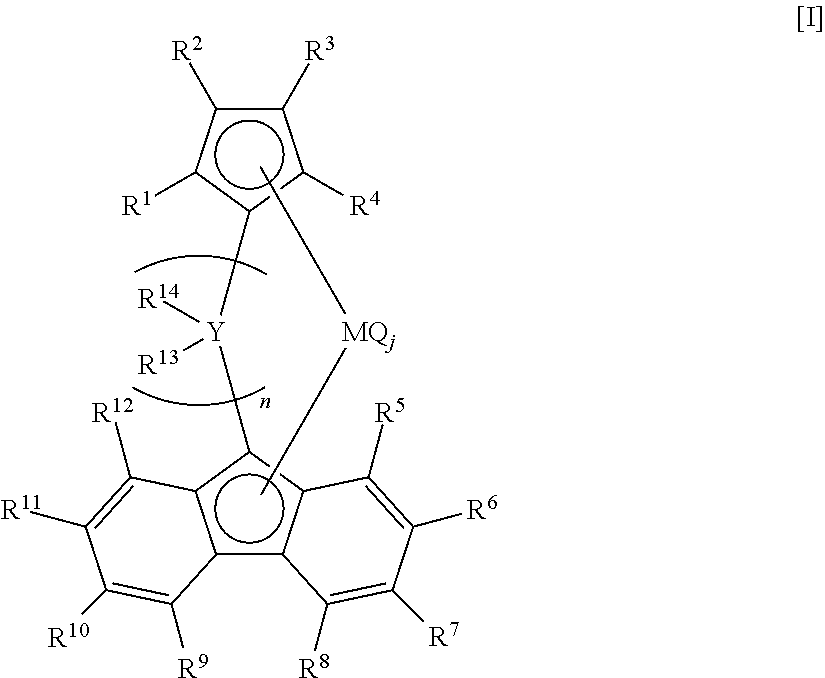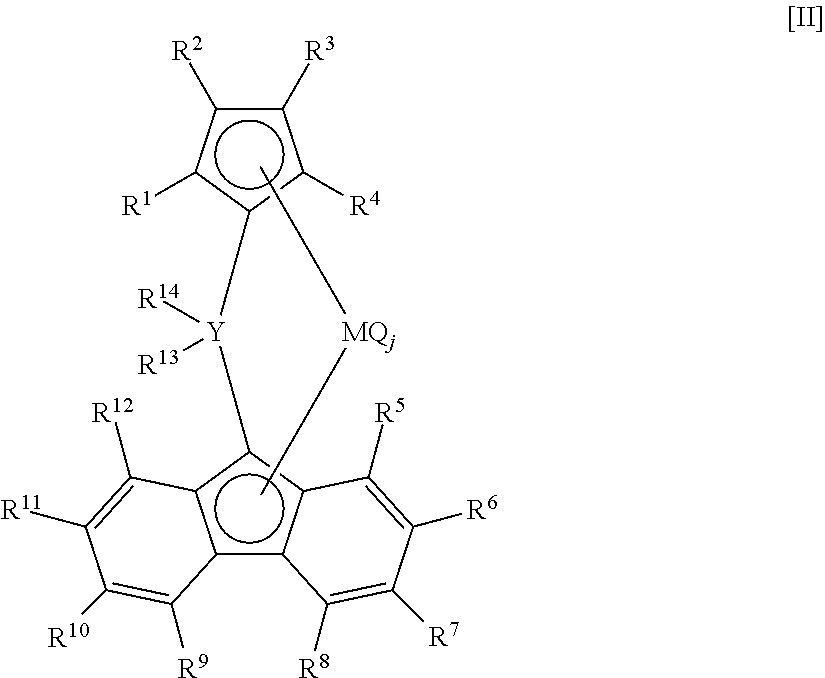Lubricant compositions
a technology of compositions and lubricants, applied in the field of lubricant compositions, can solve the problems of increasing the risk of contact between metallic parts in gears and significant damage to gears, and achieve the effects of excellent low-temperature viscosity characteristics, excellent shear stability, and good temperature viscosity characteristics
- Summary
- Abstract
- Description
- Claims
- Application Information
AI Technical Summary
Benefits of technology
Problems solved by technology
Method used
Image
Examples
example 7
Polymerization Example 7
[0288]A 2 L-volume continuous polymerizer equipped with a stirring blade and thoroughly purged with nitrogen was loaded with 1 L of dehydrated and purified hexane. Subsequently, a 96 mmol / L hexane solution of ethylaluminum sesquichloride (Al(C2H5)1.5.Cl1.5) was continuously fed at a rate of 500 mL / h for 1 hour. Further, there were continuously fed a 16 mmol / L hexane solution of VO(OC2H5)Cl2 as a catalyst at a rate of 500 mL / h, and hexane at a rate of 500 mL / h. At the same time, the polymerization liquid was continuously withdrawn from an upper portion of the polymerizer so that the volume of the polymerization liquid in the polymerizer was kept constant at 1 L. Next, 47 L / h ethylene gas, 47 L / h propylene gas and 20 L / h hydrogen gas were supplied through bubbling tubes. The copolymerization reaction was performed at 35° C. while circulating a refrigerant through a jacket fitted to the exterior of the polymerizer. The polymerization solution which included an e...
example 8
Polymerization Example 8
[0290]A 2 L-volume stainless steel autoclave that had been thoroughly purged with nitrogen was loaded with 190 mL of heptane and 405 g of propylene. After the temperature of the system had been increased to 80° C., the total pressure was increased to 3 MPaG by supplying 100 Nml of hydrogen and ethylene at 0.20 MPa. Next, 0.4 mmol of triisobutylaluminum, 0.0003 mmol of bis(η5-1,3-dimethylcyclopentadienyl) zirconium dichloride and 0.003 mmol of N,N-dimethylanilinium tetrakis(pentafluorophenyl)borate were injected with nitrogen. The mixture was stirred at a rotational speed of 400 rpm. The polymerization was thus initiated. The polymerization was performed at 80° C. for 5 minutes while keeping the total pressure at 3 MPaG by continuously supplying ethylene. The polymerization was terminated by the addition of a small amount of ethanol to the system. Unreacted ethylene, propylene and hydrogen were purged. The polymer solution obtained was washed with 1000 mL of 0...
example 1
[0304]A lubricant composition was prepared by blending, with respect to 100 mass % of the whole lubricant composition, 28.0 mass % of the copolymer from Polymerization Example 1 as the ethylene / α-olefin copolymer (B), 15.0 mass % of DIDA as the lubricant base oil (A), 6.5 mass % of the extreme pressure additive package (EP) and the balance of PAO-6 as an additional lubricant base oil (A).
PUM
| Property | Measurement | Unit |
|---|---|---|
| kinematic viscosity | aaaaa | aaaaa |
| kinematic viscosity | aaaaa | aaaaa |
| kinematic viscosity | aaaaa | aaaaa |
Abstract
Description
Claims
Application Information
 Login to View More
Login to View More - R&D
- Intellectual Property
- Life Sciences
- Materials
- Tech Scout
- Unparalleled Data Quality
- Higher Quality Content
- 60% Fewer Hallucinations
Browse by: Latest US Patents, China's latest patents, Technical Efficacy Thesaurus, Application Domain, Technology Topic, Popular Technical Reports.
© 2025 PatSnap. All rights reserved.Legal|Privacy policy|Modern Slavery Act Transparency Statement|Sitemap|About US| Contact US: help@patsnap.com



